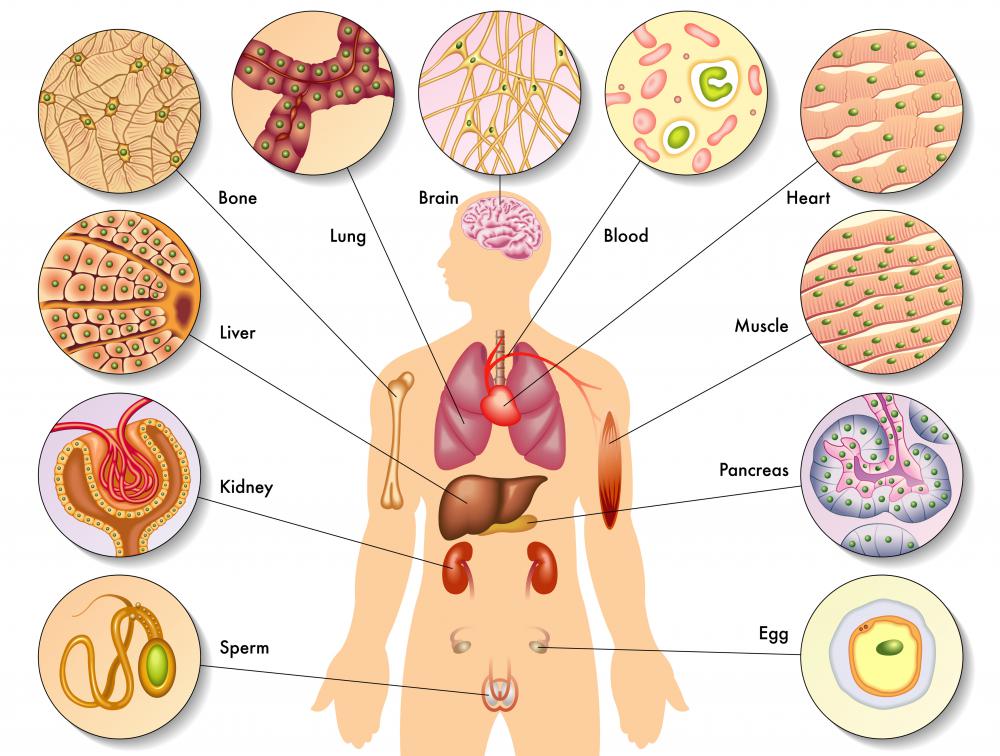At WiseGEEK, we're committed to delivering accurate, trustworthy information. Our expert-authored content is rigorously fact-checked and sourced from credible authorities. Discover how we uphold the highest standards in providing you with reliable knowledge.
What is an Artificial Organ?
An artificial organ is any human-made or developed organ intended for transplant into a living body. This includes devices such as prostheses and cochlear implants, but the ultimate goal of artificial organ research and development is fully functional created organs that can be integrated into the body which fully replaces the natural organ and remains functional for a lifetime. Many steps have been taken towards this goal, and it is very likely that the field will continue to change and develop.
Previously, an artificial organ would be created completely out of synthetic material, such as plastics or metals. These mechanical organs had some problems, such as difficulty replacing all the functions of a biological organ and a tendency to only work on a temporary basis. A significant amount of current research focuses on biological or hybrid bio-mechanical material and processes.

Artificial organ growth and/or creation research is an interdisciplinary effort. It involves scientists from fields such as medicine, cellular biology, nanotechnology, engineering, and informatics. Tissue engineering and regenerative medicine is another important area of research. It is a relatively new field which is focused on manipulating and creating living cells, often using stem cells.

There is a very high demand for organs for transplant, which exceeds the supply of organs from people who wish to donate organs. This demand will be greatly eased when an artificial organ can be used instead of a donated organ. This will save many lives and prevent a great deal of suffering because people in need of organ transplants sometimes wait for years or die before an organ is available, depending on the organ needed and the country in question.

The number of organs and other body parts and cells that can be created is steadily increasing. Most of this work is still in the early stages of development, in which cells and tissue can be created but a fully functional artificial organ cannot. Some research has progressed further, including the growth of an entire rat heart and working fetal-sized human kidneys. Researchers have also developed machines based on ink jet printers that can print healthy human skin cells, which will be very useful for burn victims and people with other large skin injuries.

A great deal of testing will be done in the future before this technology is routinely used for humans in need of new organs. Some of this research is still conceptual, and some has reached the stage of clinical trials. Researchers in 2011 estimated that it should take only another decade or two before some types of bio-engineered organs are used in transplants, but it is difficult to tell because the work is so new and discoveries are made all the time.
AS FEATURED ON:
AS FEATURED ON:















Discussion Comments
I'm still having a tough time understanding how organs can be transplanted from one person to another and still work as they are supposed to. Functioning artificial organs that replace the need for organ donors is mind boggling.
However, I imagine finding a way to stop the human body from rejecting the new organs will be a big issue initially. After all, rejection often happens when organs are transplanted from one person to another.
Anyone who has any doubts about the validity of the last paragraph where it talks about artificial organs being readily available in a decade or two need only look at the recent advances made with artificial arms, hands and legs.
The original artificial limbs were basically just there replacing the old working limbs. They were not very useful. Today's artificial limbs are actually useful. I see no reason to think that artificial organs of all types will not follow the same path.
One of my college roommates is now a biologist and she keeps up closely with the advances in medical technology. She says it is quite possible that organ growth and organ transplantation will reach a point in the not too distance future where we are able to replace human parts like we now replace worn out parts on a car.
In theory, once we are able to duplicate and transplant all of the parts of the human body we will have found the proverbial fountain of youth. When a heart gets old and worn out we can simply go to the hospital and have a new fresh one installed and we have a heart that works as well as the old one every did.
Of course replacing the brain with a new one that works as well will take a great deal of study and research, but this is interesting to imagine.
Post your comments